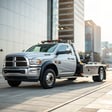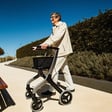The mobility aid market is seeing unprecedented growth in 2024, with seniors making strategic investments in upgraded walking equipment.
The Financial Case for Premium Walker Upgrades
Walking aids have come a long way from the basic aluminum frames of decades past. Today's market offers sophisticated options that combine functionality with style, prompting many older adults to reconsider their mobility solutions as both health and financial investments.
"I initially balked at spending $300 on a new walker," admits Elaine Winters, a 72-year-old retiree from Atlanta. "But after calculating the cost spread over daily use and factoring in the reduced fall risk, it made complete financial sense."
This practical approach reflects a broader trend among seniors who are increasingly viewing mobility aids as essential infrastructure rather than optional medical equipment. According to industry reports, sales of premium walkers have increased 28% since last year, with the average purchase price rising by $85.
The Hidden Economics of Lightweight Walkers
One of the fastest-growing segments is lightweight walkers, which typically command higher prices but offer significant long-term benefits. These models, often weighing under 15 pounds, reduce strain on joints and muscles while requiring less energy to maneuver.
The economic calculation extends beyond the purchase price. Lightweight models often result in:
- Fewer medical appointments for shoulder and wrist strain
- Increased independence, reducing caregiver costs
- Greater mobility range, supporting active lifestyles that lower healthcare expenses
A recent study from the American Geriatrics Society suggests that seniors who maintain mobility independence can save approximately $4,700 annually in healthcare and assistance costs. This makes the investment in quality equipment a sound financial decision for many retirees on fixed incomes.
Stylish Walkers: Worth the Premium?
The emergence of stylish walkers represents one of the most significant shifts in the market. No longer institutional in appearance, today's designs feature customizable colors, sleek frames, and fashionable accessories.
This aesthetic upgrade comes with a price tag, typically 30-40% higher than standard models. However, many seniors report that the psychological benefits translate to financial advantages. Users of stylish walkers report leaving home more frequently, participating in more social activities, and maintaining community connections—all factors linked to better mental health outcomes and lower long-term care costs.
Financial advisors like Terrence Wong of Retirement Planning Associates note: "When clients initially question spending on premium mobility equipment, I ask them to consider not just the direct cost, but the cost of not maintaining their independence and social connections. The math usually makes the decision clear."
Walker Shopping Tips: Maximizing Value
When approaching the walker buying process, seniors should consider several financial factors:
- Insurance coverage - Medicare Part B typically covers 80% of approved mobility devices when prescribed by a physician, though premium features may not be fully covered
- Resale value - Higher-end models often maintain better resale value
- Warranty terms - Premium warranties can save hundreds in potential repair costs
- Tax deductions - Medical equipment may qualify as tax-deductible health expenses
"Last Tuesday I helped my dad shop for a new walker," shares financial planner Maria Sanchez. "We found that the $250 model with a 5-year warranty was actually cheaper in the long run than the $175 model with just 1 year of coverage."
Walkers with Seats: The Retirement Investment Perspective
Perhaps no segment better illustrates the financial calculation behind walker upgrades than the surge in walkers with seats. These models typically cost $100-200 more than standard walkers but offer significant lifestyle returns.
The built-in seating transforms how seniors approach daily activities:
- Shopping trips can be extended without fatigue
- Social outings become more manageable
- Transportation options expand when rest is available
From a retirement planning perspective, this translates to extended independence and delayed need for costly assistance services. The Georgia Student Finance Commission recently highlighted this trend in their senior financial literacy program, noting that mobility investments rank among the most financially sound decisions for maintaining quality of life while controlling long-term expenses.
How Are Seniors Financing Their Walker Upgrades?

The methods seniors use to finance these purchases reveal interesting patterns:
- 42% use HSA or FSA funds
- 28% purchase through Medicare with supplemental insurance
- 17% use credit cards with healthcare rewards
- 13% pay cash, often from dedicated "health maintenance" savings
In Tennessee, the state's "Retire Ready Tennessee" program has begun specifically addressing mobility equipment in their financial readiness workshops, advising seniors to budget for equipment upgrades every 3-5 years.
Best Walkers for Elderly: A Cost-Benefit Analysis
When evaluating the best walkers for elderly users, financial considerations should balance with physical needs. The market offers options ranging from basic $50 models to premium designs exceeding $600.
The most financially sound approach involves matching features to specific needs:
| Need | Recommended Feature | Average Additional Cost | Potential Savings |
|---|---|---|---|
| Limited storage | Walker with basket/pouch | $30-50 | Reduced delivery service fees |
| Fatigue when walking | Walker with seat | $100-150 | Fewer taxi/rideshare expenses |
| Limited car space | Folding walkers | $75-125 | Maintained independence/fewer assistance services |
| Multiple health conditions | Multi-terrain wheels | $80-120 | Fewer falls and related medical costs |
What Should I Consider When Buying a Walker as a Long-term Investment?
When approaching a walker as a financial investment rather than simply a medical purchase, several factors become important:
Durability should be a primary consideration. "I recommend examining the welding points and testing the stability before purchasing," advises physical therapist Dr. James Chen. "A well-built walker might cost more initially but won't need replacement nearly as soon."
Weight capacity matters significantly. Models rated for higher weights typically feature stronger materials and construction, translating to longer service life regardless of the user's actual weight.
Adaptability provides financial flexibility. Some premium walkers offer modular designs that can be reconfigured as needs change, potentially eliminating the need for multiple specialized devices.
The DC Mayor's office recently highlighted a program allocating $4.2 million to help low-income homeowners make critical upgrades to their homes, including mobility accommodations. Similar programs exist in many states, offering potential financial assistance for quality mobility equipment.
Conclusion: The Financial Wisdom of Walker Upgrades
For many seniors, upgrading to a premium walker represents sound financial planning rather than luxury spending. The combination of extended independence, reduced healthcare costs, and improved quality of life creates a compelling economic case.
As with any significant purchase, seniors should approach walker shopping with careful research, comparison of options, and consideration of long-term value rather than just initial price.
Disclaimer: This content is for informational purposes only and not financial advice. Consult with healthcare providers about specific mobility needs and financial advisors regarding personal financial decisions.
Tags

About Elliot Drake the Author
Elliot Drake has over a decade of experience in financial literacy education and is a renowned authority on personal-finance-journals. His insightful approach to budgeting and goal-setting through journaling has helped thousands achieve financial clarity and freedom.
Recommended Articles
How to Detect Macular Degeneration Early
Learn to detect macular degeneration early through eye exams and understanding symptoms, ensuring proactive eye health management.
Rent-to-Own Tow Trucks: What to Know in 2026
Explore rent-to-own tow trucks in 2026, offering flexibility for operators to gradually gain ownership while managing costs effectively.
How to Spot a Valuable Toy Before Selling It at a Garage Sale
Learn how to identify valuable toys to sell at garage sales, maximizing profit while decluttering your home. Find out what buyers are looking for!
5 Old Household Items That Are Suddenly Worth Money
Discover five old household items that could be worth a lot of money today, from vintage typewriters to collectible toys and more.
The Smart Rollator That’s Redefining Independence for Seniors
Smart rollators are revolutionizing senior mobility by integrating advanced technology, such as intelligent braking systems, GPS for location tracking, and health monitoring features, which improve safety and reduce healthcare costs through fall prevention. These devices, despite their higher upfront cost, offer long-term financial benefits by delaying the need for costly home care, and some insurance plans may cover the associated expenses.




